Related Research Articles

The history of Latvia began around 9000 BC with the end of the last glacial period in northern Europe. Ancient Baltic peoples arrived in the area during the second millennium BC, and four distinct tribal realms in Latvia's territory were identifiable towards the end of the first millennium AD. Latvia's principal river Daugava, was at the head of an important trade route from the Baltic region through Russia into southern Europe and the Middle East that was used by the Vikings and later Nordic and German traders.
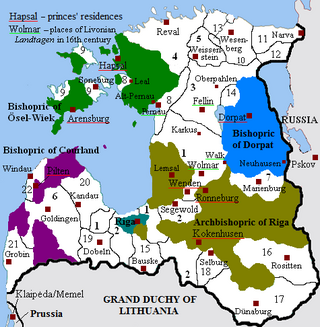
Livonia or in earlier records Livland, is a historical region on the eastern shores of the Baltic Sea. It is named after the Livonians, who lived on the shores of present-day Latvia.

Baltic Germans are ethnic German inhabitants of the eastern shores of the Baltic Sea, in what today are Estonia and Latvia. Since their resettlement in 1945 after the end of World War II, Baltic Germans have markedly declined as a geographically determined ethnic group in the region.
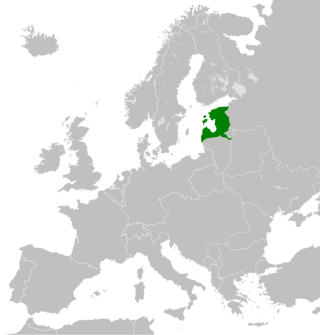
The United Baltic Duchy, or alternatively the Grand Duchy of Livonia, was the name of a short-lived state during World War I that was proclaimed by leaders of the local Baltic German nobility.
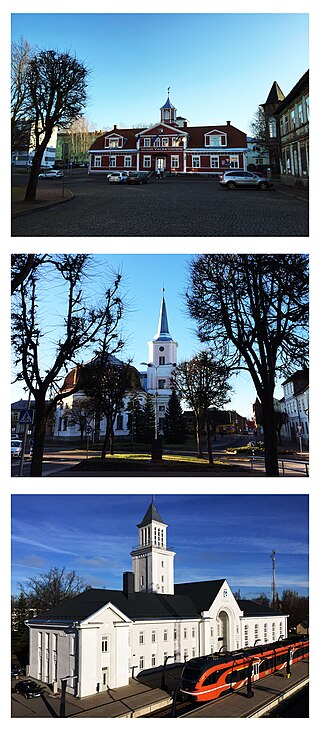
Valga is a town in southern Estonia and the capital of Valga County and Valga Parish. Until their separation in 1920, Valga and the town of Valka in northern Latvia were one town. They are now twin-towns. The area of Valga is 16.5 square kilometres and that of Valka is 14.2 km2 (5.5 sq mi). Their populations are respectively 12,261 and 6,164. On 21 December 2007 all border-crossing points were removed and roads and fences opened between the two countries with both countries joining the Schengen Agreement.

Valga County is a first-level administrative unit and one of 15 counties of Estonia. It comprises the former area of Valga District. The present-day county was created on 1 January 1990. The capital and largest town of Valga County is Valga, followed by Tõrva and Otepää. It is situated in the southern part of the country and borders Põlva and Võru County to the east, Latvia to the south and west, and Viljandi and Tartu County to the north. 27,650 people live in Valga County as of 2022.

Võru is a town and a municipality in south-eastern Estonia. It is the capital of Võru County and the centre of Võru Parish.

The Governorate of Livonia, also known as the Livonia Governorate, was a province (guberniya) and one of the Baltic governorates of the Russian Empire, Baltic Governorate-General until 1876. Governorate of Livonia bordered Governorate of Estonia to the north, Saint Petersburg and Pskov Governorates to the east, Courland Governorate to the south, and the Gulf of Riga to the west. In 1897, the population of the governorate was 1,299,365, and it had an area of 47,030.87 square kilometres (18,158.72 sq mi). The administrative centre of the governorate was the Baltic Sea port of Riga. It roughly corresponded to most of the modern Vidzeme Region of Latvia and southern Estonia.

Alūksne is a town on the shores of Lake Alūksne in northeastern Latvia near the borders with Estonia and Russia. It is the seat of the Alūksne municipality. Alūksne is the highest elevated Latvian city, located in East Vidzeme Upland at 217 m above sea level. The high elevation of the city affects the social and physical arrangement of the place.

Vidzeme is one of the Historical Latvian Lands. The capital of Latvia, Riga, is situated in the southwestern part of the region. Literally meaning "the Middle Land", it is situated in north-central Latvia north of the Daugava River. Sometimes in German, it was also known as Livland, the German form from Latin Livonia, though it comprises only a small part of Medieval Livonia and about half of Swedish Livonia. Most of the region's inhabitants are Latvians (85%), thus Vidzeme is the most ethnically Latvian region in the country.
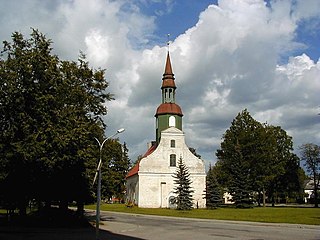
Valka is a town and municipality in northern Latvia, on the border with Estonia along both banks of the river Pedele.

The rail transport system in Estonia consists of about 1,200 kilometres (750 mi) of railway lines, of which 900 kilometres (560 mi) are currently in public use. The infrastructure of the railway network is mostly owned by the state and is regulated and surveyed by the Estonian Technical Surveillance Authority.

Mõtsa Pūol or Metsepole was a medieval Livonian county inhabited by the Finnic-speaking Livonians, situated on the east coast of the Gulf of Riga, in most part at the northwest of the Vidzeme region of what is now Latvia, and including some adjacent areas in the present-day Pärnu County of Estonia. Metsepole was bordered by the ancient Estonian Sakala County to the north, Latgalian Tālava to the east and Livonian county of Turaida to the south.
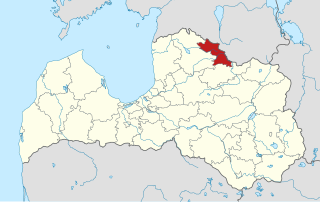
Valka Municipality is a municipality in Vidzeme, Latvia. The municipality was formed in 2009 by merging Valka town, Ērģeme Parish, Kārķi Parish, Valka Parish, Vijciems Parish and Zvārtava Parish; the administrative centre being Valka. In 2016 it was announced that due to better welfare and higher salaries in neighbouring Estonia, over 10% of municipality's inhabitants have registered themselves as inhabitants of Valga County. The population in 2020 was 7,603.
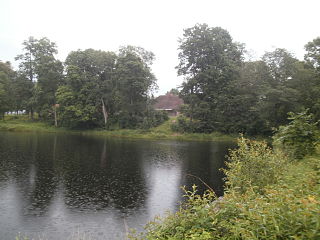
Lugaži is a village in the Valka Parish of Valka municipality in Latvia.

Werro County was one of the nine subdivisions of the Governorate of Livonia of the Russian Empire. It was situated in the northeastern part of the governorate. Its capital was Võru (Werro). The territory of Kreis Werro corresponds to the present-day Võru County, most of Põlva County and parts of Valga County.

Valka County was a historic county in the Governorate of Livonia, and in the Republic of Latvia dissolved during the administrative territorial reform of the Latvian SSR in 1949. Its capital was Valka (Walk).
City Twins Association is an association that develops cooperation between its members. The association represents the interests of twin cities that are divided into two and between two different countries, but form a one entity in terms of population, economy and society.
References
- ↑ "History". Visit Valga Valka. Retrieved 20 January 2022.
- ↑ "Valga. Valka" (PDF). visitvalgavalka.com. Retrieved 17 March 2022.
- 1 2 ПЕРВАЯ ВСЕОБЩАЯ ПЕРЕПИСЬ НАСЕЛЕНІЯ. РОССІЙСКОЙ ИМПЕРІИ 1897 г. XXІ. ЛИФЛЯНДСКАЯ ГУБЕРНІЯ [First General Population Census. Russian Empire, year 1897. XXI. Livonian Governorate.] (in Russian). St. Petersburg: Central Statistical Committee of the Ministry of Interior of the Russian Empire. 1905. pp. 2–3 (28).
57°46′18″N26°01′11″E / 57.77167°N 26.01972°E